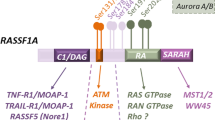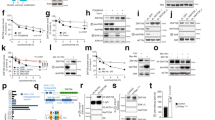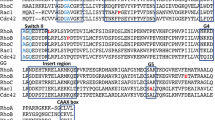Abstract
RASSF1A is a putative tumor suppressor gene that is inactivated in a variety of human tumors. Expression of exogenous RASSF1A has been shown to inhibit tumor growth in vitro and in animals. However, the molecular mechanisms by which RASSF1A mediates its tumor suppressive effects remain to be elucidated. Here, we report that RASSF1A is a microtubule-binding protein that interacts with and stabilizes microtubules. We have identified the RASSF1A region harboring a basic domain that appears to mediate the interactions between RASSF1A and microtubules. The basic domain-containing RASSF1C isoform also interacts with and stabilizes microtubules. We further show that in addition to G1 arrest, RASSF1A promotes growth arrest in the G2/M phase of the cell cycle and endogenous RASSF1A also interacts with microtubules. Based on our results, we propose that RASSF1A may mediate its tumor suppressive effects by inducing growth arrest in the G1 and G2/M phases. Together, these results provide important new insights into the molecular mechanisms by which this novel tumor suppressor mediates its biological effects.
This is a preview of subscription content, access via your institution
Access options
Subscribe to this journal
Receive 50 print issues and online access
$259.00 per year
only $5.18 per issue
Buy this article
- Purchase on Springer Link
- Instant access to full article PDF
Prices may be subject to local taxes which are calculated during checkout










Similar content being viewed by others
References
Agathanggelou A, Honorio S, Macartney DP, Martinez A, Dallol A, Rader J, Fullwood P, Chauhan A, Walker R, Shaw JA, Hosoe S, Lerman MI, Minna JD, Maher ER and Latif F . (2001). Oncogene, 20, 1509–1518.
Albert B, Bray D, Lewis J, Raff M, Roberts K and Watson JD . (2002). Molecular Biology of the Cell, 4th edn. Garland Publishing: New York, pp. 907–1061.
Amon A . (1999). Curr. Opin. Genet. Dev., 9, 69–75.
Askham JM, Moncur P, Markham AF and Morrison EE . (2000). Oncogene, 19, 1950–1958.
Bandara LR and La Thangue NB . (1991). Nature, 351, 494–497.
Berrueta L, Kraeft SK, Tirnauer JS, Schuyler SC, Chen LB, Hill DE, Pellman D and Bierer BE . (1998). Proc. Natl. Acad. Sci. USA, 95, 10596–10601.
Bhalla KN . (2003). Oncogene, 22, 9075–9086.
Bienz M . (2002). Nat. Rev. Mol. Cell Biol., 3, 328–338.
Bosc C, Cronk JD, Pirollet F, Watterson DM, Haiech J, Job D and Margolis RL . (1996). Proc. Natl. Acad. Sci. USA, 93, 2125–2130.
Burbee DG, Forgacs E, Zochbauer-Muller S, Shivakumar L, Fong K, Gao B, Randle D, Kondo M, Virmani A, Bader S, Sekido Y, Latif F, Milchgrub S, Toyooka S, Gazdar AF, Lerman MI, Zabarovsky E, White M and Minna JD . (2001). J. Natl. Cancer Inst., 93, 691–699.
Byun DS, Lee MG, Chae KS, Ryu BG and Chi SG . (2001). Cancer Res., 61, 7034–7038.
Cassimeris L . (1999). Curr. Opin. Cell Biol., 11, 134–141.
Dammann R, Li C, Yoon J-H, Chin PL, Bates S and Pfeifer GP . (2000). Nat. Genet., 25, 315–319.
Dammann R, Takahashi T and Pfeifer GP . (2001a). Oncogene, 20, 3563–3567.
Dammann R, Yang G and Pfeifer GP . (2001b). Cancer Res., 61, 3105–3109.
Deka J, Kuhlmann J and Muller O . (1998). Eur. J. Biochem., 253, 591–597.
Downing KH . (2000). Annu. Rev. Cell Dev. Biol., 16, 89–111.
Dreijerink K, Braga E, Kuzmin I, Geil L, Duh FM, Angeloni D, Zbar B, Lerman MI, Stanbridge EJ, Minna JD, Protopopov A, Li J, Kashuba V, Klein G and Zabarovsky ER . (2001). Proc. Natl. Acad. Sci. USA, 98, 7504–7509.
Erimann JDR and Jackson PK . (2002). Nature, 416, 850–854.
Goedert M, Baur CP, Ahringer J, Jakes R, Hasegawa M, Spillantini MG, Smith MJ and Hill F . (1996). J. Cell Sci., 109, 2661–2672.
Goode BL, Chau M, Denis PE and Feinstein SC . (2000). J. Biol. Chem., 275, 8182–38189.
Graham FL, Smiley J, Russell WC and Nairn R . (1977). J. Gen. Virol., 36, 59–74.
Gustke N, Trinczek B, Biernat J, Mandelkow EM and Mandelkow E . (1994). Biochemistry, 33, 9511–9522.
Huang Y, He Q, Hillman MJ, Rong R and Sheikh MS . (2001). Cancer Res., 61, 6918–6924.
Irminger-Finger I, Laymon RA and Goldstein LS . (1990). J. Cell Biol., 111 (6 Part 1), 2563–2572.
Kaplan KB, Burds AA, Swedlow JR, Bekir SS, Sorger PK and Nathke IS . (2001). Nat. Cell Biol., 3, 429–432.
Kinzler KW and Vogelstein B . (1996). Cell, 87, 159–170.
Kok K, Naylor SL and Buys CH . (1997). Adv. Cancer Res., 71, 27–92.
Lee MG, Kim HY, Byun DS, Lee SJ, Lee CH, Kim JI, Chang SG and Chi SG . (2001). Cancer Res., 61, 6688–6692.
Liu L, Tommasi S, Lee D-H, Dammann R and Pfeifer G . (2003). Oncogene, 22, 8125–8136.
Lo KW, Kwong J, Hui AB, Chan SY, To KF, Chan AS, Chow LS, Teo PM, Johnson PJ and Huang DP . (2001). Cancer Res., 6, 3877–3881.
Lodish H, Berk A, Zipursky SL, Matsudaira P, Baltimore D and Darnell J . (2000). Molecular Cell Biology, 4th edn. W.H. Freeman and company: New York, pp. 795–847.
Ludlow JW, Shon J, Pipas JM, Livingston DM and DeCaprio JA . (1990). Cell, 60, 387–396.
Maitra A, Wistuba II, Washington C, Virmani AK, Ashfaq R, Milchgrub S, Gazdar AF and Minna JD . (2001). Am. J. Pathol., 159, 119–130.
Mimori-Kiyosue Y and Tsukita S . (2001). J. Cell Biol., 154, 1105–1109.
Mogensen MM, Tucker JB, Mackie JB, Prescott AR and Nathke IS . (2002). J. Cell. Biol., 157, 1041–1048.
Morrissey C, Martinez A, Zatyka M, Agathanggelou A, Honorio S, Astuti D, Morgan NV, Moch H, Richards FM, Kishida T, Yao M, Schraml P, Latif F and Maher ER . (2001). Cancer Res., 61, 7277–7281.
Nakamura M, Zhou XZ and Lu KP . (2001). Curr. Biol., 11, 1062–1067.
Nogales E . (2001). Annu. Rev. Biophys. Biomol. Struct., 30, 397–420.
Oliferenko S and Balasubramanian MK . (2002). Nat. Cell Biol., 4, 816–820.
Reese EL and Haimo LT . (2000). J. Cell Biol., 151, 155–166.
Rong R, He Q, Liu Y, Sheikh MS and Huang Y . (2002). Oncogene, 21, 1062–1070.
Rudner AD and Murray AW . (1996). Curr. Opin. Cell Biol., 8, 773–780.
Schuyler SC and Pellman D . (2001). J. Cell Sci., 114 (Part 2), 247–255.
Shimoda SL and Solomon F . (2002). Cell, 109, 9–12.
Shivakumar L, Minna J, Sakamaki T, Pestell R and White MA . (2002). Mol. Cell. Biol., 22, 4309–4318.
Smith KJ, Levy DB, Maupin P, Pollard TD, Vogelstein B and Kinzler KW . (1994). Cancer Res., 54, 3672–3675.
Song MS, Song SJ, Ayad NG, Chang JS, Lee JH, Hong HK, Lee H, Choi N, Kim J, Kim H, Kim JW, Choi E-J, Kirschner MW and Lim Dae K . (2004). Nat. Cell Biol., 6, 129–137.
Szalay J, Bruno P, Bhati R, Adjodha J, Schueler D, Summerville V and Vazeos R . (2001). J. Histochem. Cytochem., 49, 49–66.
Tanaka TU . (2002). Curr. Opin. Cell Biol., 14, 365–371.
Walczak CE . (2000). Curr. Opin. Cell Biol., 12, 52–56.
Walenta JH, Didier AJ, Liu X and Kramer H . (2001). J. Cell Biol., 152, 923–934.
Whang-Peng J, Kao-Shan CS, Lee EC, Bunn PA, Carney DN, Gazdar AF and Minna JD . (1982). Science, 215, 181–182.
Wistuba II, Behrens C, Virmani AK, Mele G, Milchgrub S, Girard L, Fondon III JW, Garner HR, McKay B, Latif F, Lerman MI, Lam S, Gazdar AF and Minna JD . (2000). Cancer Res., 60, 1949–1960.
Yoon JH, Dammann R and Pfeifer GP . (2001). Int. J. Cancer, 94, 212–217.
Acknowledgements
We thank Dr Peter C Keng at the Cell Separation and Flow Cytometry Facility, University of Rochester for assisting in cell cycle analyses. This work was supported in part by National Institutes of Health Grants CA86945 and DK62136-01. Correspondence and requests for material should be addressed to YH.
Author information
Authors and Affiliations
Corresponding author
Rights and permissions
About this article
Cite this article
Rong, R., Jin, W., Zhang, J. et al. Tumor suppressor RASSF1A is a microtubule-binding protein that stabilizes microtubules and induces G2/M arrest. Oncogene 23, 8216–8230 (2004). https://doi.org/10.1038/sj.onc.1207901
Received:
Revised:
Accepted:
Published:
Issue Date:
DOI: https://doi.org/10.1038/sj.onc.1207901
Keywords
This article is cited by
-
Atomistic molecular dynamics simulations of tubulin heterodimers explain the motion of a microtubule
European Biophysics Journal (2021)
-
Microtubule-associated tumor suppressors as prognostic biomarkers in breast cancer
Breast Cancer Research and Treatment (2020)
-
RASSF1A, puppeteer of cellular homeostasis, fights tumorigenesis, and metastasis—an updated review
Cell Death & Disease (2019)
-
A role for RASSF1A in tunneling nanotube formation between cells through GEFH1/Rab11 pathway control
Cell Communication and Signaling (2018)
-
Epigenetic silencing of RASSF1A deregulates cytoskeleton and promotes malignant behavior of adrenocortical carcinoma
Molecular Cancer (2013)



